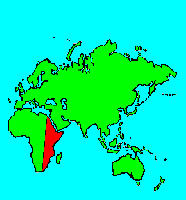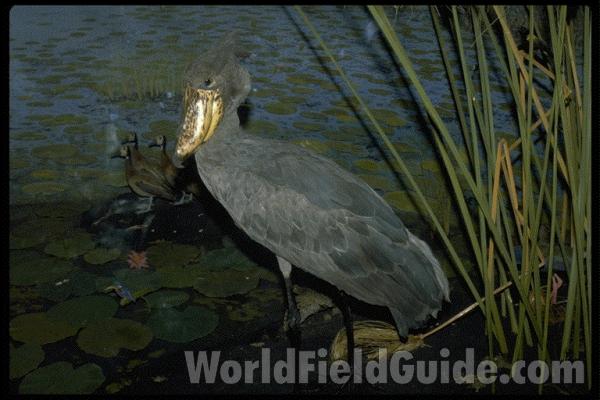SPECIES INFO
Shoebill or Whale Headed Stork (Balaeniceps rex) is found only in the central part of Africa. The unusually large bill and dark gray color and sixty inches of length help identify this large and unusual species.
There are no subspecies.
The Shoebill was listed in CITES Convention of Endangered Species in l987. Its population status in l992 indicated that, although it was not in immediate danger of extinction, it has attracted considerable conservation attention.Whale headed or shoebill stork genus (Balaeniceps) contains a single African species. The member of this genus is about 60 inches inches in length. The blue-gray color and the unique giant duck like bill puts this genus in its own family.
Balaenicipitidae family contains one species of bird, the shoebill, Balaeniceps rex, unique enough to be given family status. We have herein also moved the unrelated hammerkop, Scopus ubmretta, which is usually placed in its own family, the Scopidae, into this grouping.
Stork and Heron group (Order Ciconiiformes) is made up of birds with long legs that usually are found near the shores of bodies of water. Their long legs let them wade through the shallow water looking for food. Fossil remains indicate these birds have been around for at least 100 million years. There are about 114 living species in this group.
Aves contains about 8,650 different species of living birds known to science. Each year about one new species is discovered in some remote rain forest or remote island. In addition, scientists have been raising many subspecies to full species status which may raise the species count to 10,000. Birdlife recognizes 10,027 species as of 2011.
However, each year about one species goes extinct. The rate of extinction is increasing, and the rate of new discovery is decreasing, so that the number of bird species will soon begin to decline rapidly. Although different taxonomists would organize the birds differently, there are approximately twenty-seven orders of birds. These orders are broken down into about one hundred and fifty-five different families.
Recent research of the genetic structure of some of the shore birds and owls would indicate that the present organization of orders and families should have some modification.
The birds are a worldwide group of animals that are characterized by having the front limbs modified into wings that are used for flying. Perhaps the most unique feature of the birds is the feathers. These feathers are made up of a central support called a quill and a series of small filaments that are hooked together as barbs.
For many years it was believed that Archaeopteryx discovered in Bavaria was the oldest bird from about 150 million years ago. However, in l986, Sankar Chattterjee, a Texas paleontologist, reportedly discovered a bird in the genus Protoavis that lived about 225 million years ago.
When this project was begun in 1978, we used Austin & Singer for bird taxonomy. Since then, we have adopted many changes, but have kept some older concepts that are still found widely in the literature. Recently, we have used Clements and Howard & Moore. Very recently, we have used Monroe and Sibley for the higher taxonomy of the perching birds.
Backboned Animals (Phylum Chordata) are the most advanced group of animals on earth. These animals are characterized by having a spinal cord or backbone. Most members have a clearly defined brain that controls the organism through a spinal cord. Fish, amphibians, reptiles, birds, and mammals are in this phylum.
Currently, some taxonomists believe that the fish should be divided into two groups (sharks and regular fishes) and that there are some other primitive groups in the phylum such as hagfish or lampreys.
Animal Kingdom contains numerous organisms that feed on other animals or plants. Included in the animal kingdom are the lower marine invertebrates such as sponges and corals, the jointed legged animals such as insects and spiders, and the backboned animals such as fish, amphibians, reptiles, birds, and mammals.


